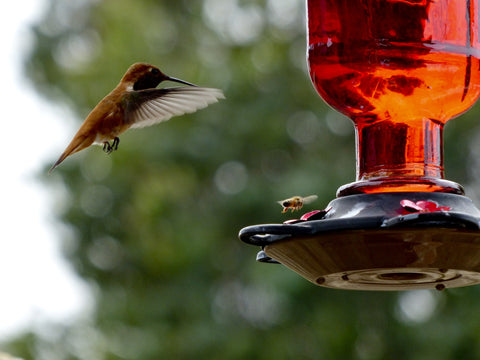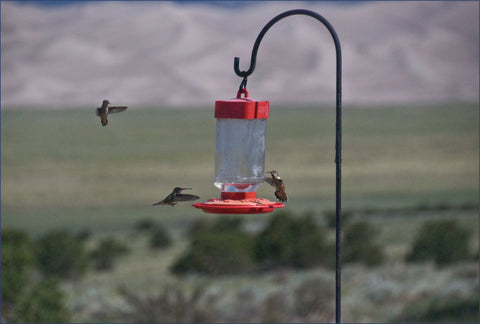How to Make Your Own Hummingbird Nectar
Hummingbirds are one of the world’s smallest bird species, but it is surprising to know that they have the greatest mass-specific metabolic rate than any homeothermic animal.
These jewel-like flying creatures can hover mid-air at a rapid rate of up to 80 beats per second. Furthermore, their heart and respiratory rates can go as fast as 1,260 beats and 250 breaths per minute, respectively.
Their oxygen consumption per gram of muscle tissue during flight is also 10 times higher than that of an elite human athlete.

Hummingbirds use up 100% of the sugar they ingested to fuel their expensive hovering flights.
They can quickly utilize the newly ingested sugar within 30 to 45 minutes after consumption. This means that these feathery treasures can quickly oxidize sugar in flight muscles to satisfy their extremely high metabolic demands.
To satisfy their ultrafast metabolism, hummingbirds need to consume half their body weight, feed themselves every 10 to 15 minutes, and visit thousands of flowers every day.
You can lend a hand to your hovering visitors by supplying and providing them with the nutrients and food they need, which is nectar.
With just a few simple ingredients, you can fill your hummer feeder anytime. Here is the best hummingbird nectar recipe and how you can make it.

The materials you will need to prepare include 1 cup of refined white sugar, 4 cups of boiling water, a bowl, and a spoon. Now, carefully follow these steps below:
- Boil 4 cups of water.
- Add and stir 1 cup of white sugar until fully dissolved.
- Bring the mixture to a boil then remove it from the heat. Remember not to boil it for long as the ratio changes as water is boiled off.
- Cover and allow the mixture to cool.
- Skip the red food coloring.
- Fill your hummingbird feeder with the solution.
More hummingbird nectar recipe tips
Although making nectar for hummingbirds looks easy, there are other factors you need to consider to ensure the overall safety of your homemade treat.
- Filtered water is preferred. Tap water tends to have a strong taste and odor and likely contains heavy chemicals. Boiling is necessary to remove the chlorine in the water and eliminate mold and yeast pores in the sugar.

- Use white cane sugar only. When buying, check the label properly. If it is not specifically indicated, then it is most likely beet sugar.
There is nothing really wrong with beet sugar, but many studies have recommended the use of cane sugar for birds. A flower nectar contains 21% to 23% sucrose, which is just the same as your regular table sugar.
- Do not use artificial sugar substitutes, brown sugar, honey, and molasses. Hummingbirds find them heavy to digest and they can also ferment easily. It can develop molds that are harmful to hummingbirds.
- Make sure the nectar has been completely cooled down before filling the feeders.
A hot mixture can cause damage to the feeders and can quickly ferment once it becomes contaminated.
- Commercial hummingbird nectar products are not necessary. You will be lured to buy them as they are advertised to contain vitamins and they come in different flavors. You really do not have to shell out an extra cash as a simple sugar solution will suffice their health needs.
- Unused hummingbird nectar can only be stored inside the refrigerator for one week. So, if you plan to make your own nectar, make sure it will last just for a week only.
This is to minimize the waste and ensure that your hummers receive the freshest nectar available.
- Always clean your feeders at least once a week to prevent contamination. The need may vary depending on the weather.
For instance, a warm weather can easily spoil the syrup so your feeder may need daily cleaning. Do not let the syrup turn into a cloudy consistency.

- Do not use red dye. According to Bird Watcher’s Digest, red dye caused cancer, tumors, and decrease reproduction rates in rats and mice. Although there are no scientific tests done on hummingbirds, anecdotal evidence revealed an increased skin and bill tumors.
Besides, there are other ways to incorporate the red color, such as a feeder, feeding ports, or other decorative garden accents.
- Protect your feeder against ants and bees. Hummingbirds will not go to feeders with ants crawling around or floating. However, do not use insecticides as you are also eliminating their only source of protein --- insects.
Overall, following this classic homemade humming nectar recipe is a great way to provide food for your hovering visitors. It is also less expensive and entails only a few simple steps and ingredients.
With this, you can conveniently fill your hummingbird feeders with the sweet sugar treat all year long.

